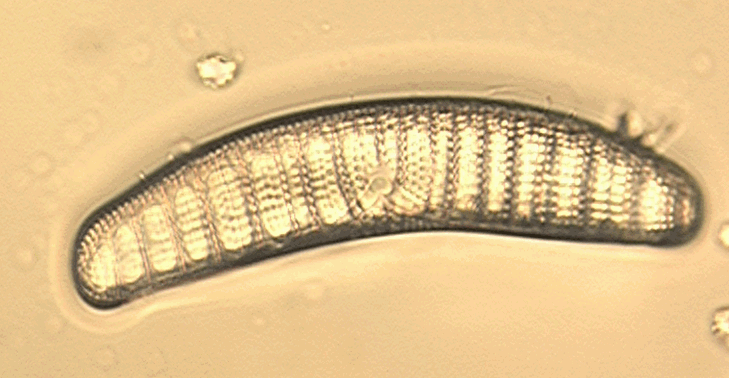The valve has a convex dorsal margin, ventral margin slightly concave to straight. Apicies are not differentiated from the body of the valve. The raphe is only appearent in the middle of the valve in valve view, curved towards dorsal margin. The central pores of the raphe are located below the mid-width of the valve. Poores in the central canal plate are indistinct. Distinct costae, in girdle view ends of costae indistinctly capitate or rounded. Caracteristics of this species are the central pores of the raphe are located below the midpoint of the valve width. Rows of alveoli are more than two between the costae. In girdle view the costat are rounded and not distinctly capitate. This nominante has a valve not differentiated or set off from valve main body.
(Patrick and Reimer 1975).
Special note
Hustedt 1930 lists this Epithemia under the name Epithemia zebra, a synonym. (Patrick and Reimer 1975).
and (Krammer and Lange-Bertalot 1988).
list it under the name E. adnata. E. adnata has been used here because that name was given before E. zebra.
Type Locality
USA, New England states, Middle Atlantic states, South Eastern states, Gulfcoast states, South Central states, East Central states, West Central states, Lake states, Plains states, Colorado, Wyoming, Montana, Utah, California, Oregon and Washington. (Patrick and Reimer 1975).
Synonyms
Epithemia zebra( Ehr.) Kutz., Bacill., p. 34, pl. 5, figs. 12,6(abc). 1844
Frustulia adnata Kutz., Alg., Dec 5, No41. 1833.
Frustulia adnata Kutz., linnaea, 8:544, pl. 13 fig. 15. 1833
Navicula zebra Ehrenberg 1833, p. 262; Ehrenberg 1838, p. 191, 14/7.
Eunotia zebra (Ehr.) Ehr., Infusionsthierchen, p. 191, pl. 14, fig 7 (As N. zebra) pl. 21, fig 19. 1838.
Cystopleura zebra (Ehr.) Kuntze, Reviso Gen. Plant., vol. 2, p. 891. 1891
(Patrick and Reimer 1975).
Ecological distribution
Found in lakes, ponds, rivers, springs/streams, lagoons, pools, oozing areas, thermal springs, swamps, and terrestrial pH: Acidobiontin, Acidophilous, Indifferent, Alkaliphilous, Alkalibiontic. Halobion: Oligohalobous, indifferent, euryhalobous. Saprobien: Beta range oligosaprobic (saproxenous to beta-mesosaprobic), saporxenous. Current: Indifferent, rheobiontic. Specific habitat: periphytic. Temperature: Euthermal, Mesothermal, Eurythermal. (Beaver 1981).
Length is 15 to 150 micrometers (Patrick and Reimer 1975)
Width is 7 to 14 micrometers (Patrick and Reimer 1975)
Costae are about 3 to 5 in 10 micrometers (Patrick and Reimer 1975).
Alveoli rows are 12 to 14 in 10 micrometers (Patrick and Reimer 1975).
